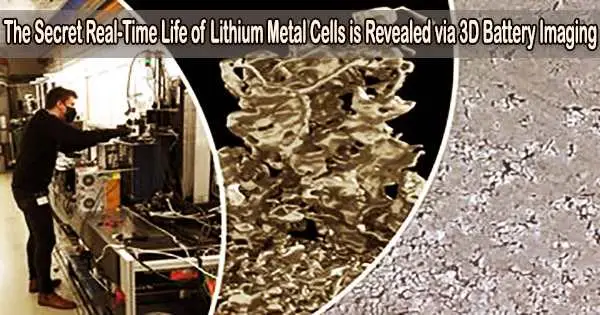Innovative battery experts have figured out how to create 3D photos of the unstable but promising lithium metal battery as it cycles in real-time. A team from Chalmers University of Technology in Sweden has successfully observed the behavior of the lithium metal in the cell while charging and discharging.
The new technique could lead to batteries in our upcoming vehicles and technology that are safer and have a higher capacity.
“We’ve opened a new window in order to understand and in the long term to optimise the lithium metal batteries of the future. When we can study exactly what happens to the lithium in a cell during cycling, we gain important knowledge of what affects its inner workings,” says Aleksandar Matic, professor at the Department of Physics at Chalmers and head of the scientific study that was recently published in Nature Communications.
There are great expectations for novel battery technologies like lithium metal batteries to succeed where lithium-ion batteries already excel. The objective is to create safer, more energy-dense batteries that will enable us to go farther for less money and damage to the environment.
Among the options touted as promising alternatives are lithium-sulfur, lithium-oxygen, and solid-state batteries. All of these theories are predicated on the notion that lithium metal, rather than the graphite found in current batteries, would serve as the anode.
The battery cell will be lighter without graphite, and it will be able to use high-capacity cathode materials with lithium metal as the anode. This makes it possible to achieve three to five times the energy density.
We’ve opened a new window in order to understand and in the long term to optimise the lithium metal batteries of the future. When we can study exactly what happens to the lithium in a cell during cycling, we gain important knowledge of what affects its inner workings.
Professor Aleksandar Matic
Lithium forms undesired microstructures
Lithium metal batteries do, however, have one significant drawback: lithium does not always deposit as flatly and smoothly as it should when the battery is charged or discharged. Parts of the deposited lithium can become separated and become inactive because it frequently forms mossy microstructures or dendrites, long needle-like structures.
Dendrites, also risk reaching the other battery electrode and cause a short circuit. Therefore, it is crucial to understand when, how, and why these structures form.
“To be able to use this technology in the next generation of batteries, we need to see how a cell is affected by factors such as current density, the choice of electrolyte, and the number of cycles. Now we have a tool to do so,” says Chalmers researcher Matthew Sadd, head author of this new study along with his colleague Shizhao Xiong.
Excited wait for the first glimpse
The Swiss Light Source, located outside of Zurich, undertook the experiment to see how lithium microstructures formed in a functioning cell. The scientists built a specifically designed battery cell with bated breath in order to use X-ray tomographic microscopy to observe the deposition of lithium in real time and in three dimensions.
The team was unaware of any attempts to investigate lithium metal in a functioning cell, despite the desire of numerous researchers to do so. If they were successful, it would be a significant improvement over analyzing photos after a cell had cycled.
“It was magical when we saw with our own eyes that it worked on the first attempt,” Matic said. “When we observed the lithium creating big structures, like huge needles, it was almost like being in a lunar landing project. We’ve been wanting to observe the inner workings of batteries in real time for so long. And now we can.”
Key piece of the puzzle for large-scale use
The research team now plans to test the method using several battery designs in the hopes that the required imaging equipment will be accessible locally, for instance at the Swedish MAX IV lab, a national research facility for cutting-edge x-ray investigations.
“We’re looking forward to developing this method to take faster measurements at higher resolution to see more detailed microstructures formed early on in the deposition process,” Matic says. “This is a key piece of the puzzle to be able to use lithium metal batteries on a large scale and make them safe. A lot of research teams and companies are looking at the lithium metal concept for their future prototypes.”





